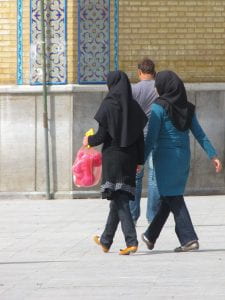by Gelara Fanaeian, the Law School, University of Bristol
This blog post is the second part of a two-part review of the Hijab and Chastity Bill. In the first section, the fundamental elements of the Hijab and Chastity Bill, the UN’s approach toward it, the legal and political background that led to its establishment, and its effect on women’s right to health were discussed. In this section, Iran’s obligation to international human rights law and the role of the international community will be analysed briefly.
Iran’s obligation to international human rights law and the role of the international community
Through a human rights lens, and by emphasising the conventions ratified by Iran, the Hijab and Chastity Bill conflicts with Iran’s obligation to ‘respect’ the right to health. Particularly, it is against Iran’s obligation under Article 12 of the United Nations Convention on Economic, Social and Cultural Rights. Relying on General Comment No. 14, the incompatibility can be recognised at different levels: general legal obligation (paragraph 30), specific legal obligation (paragraph 37) and more importantly, core obligation (paragraphs 43 and 48). The Bill will institutionalise discriminatory health policies, violate equal accessibility of healthcare services, threaten the mental health of Iranian women, undermine equal participation in health-related decision-making and have the potential to restrict access to sexual and reproductive health education. Overall, it has weaponised healthcare services to oppress women’s opposition to the mandatory hijab. It legitimises hegemonic masculinity in health law and policies. In the long term, it will undermine the health status of Iranian women and deprive them of the enjoyment of other human rights and equal opportunities within their societies.
It should be noted that, for decades, overly conservative Islamic governments have been justifying women’s rights violations by relying on cultural relativism. In this specific scenario, some might rely on cultural values and the conceptual nature of the parliament in democratic systems – as representatives of society – and ask, since citizens vote for the parliament members, how we as external or in some cases Western observers can question their decisions. To respond to this debate, two aspects need to be clarified.
The first is related to the concept of democracy and the Iranian legal system. From a legal aspect, for this bill to became law, it needed to be approved by the parliament and ratified by the Guardian Council, an Islamic establishment with the power to veto legislation and oversee elections and the responsibility to review all regulations designed by the parliament. Six of the 12 members are directly appointed by the supreme leader. Oher half are nominated by the Head of the Judicial to be elected by the parliament. However, Head of the Judicial is appointed by the supreme leader, and MPs are chosen under Guardian Council supervision, meaning they have the power not to accept candidates for election. In this way, the loop of undemocratic power is ongoing, and laws are imposed through top-down policies. Secondly, to determine the scope of cultural relativism, the difference between core principles of human rights and peripheral aspects should be recognised. Core principles cannot be undermined under the shadow of cultural or religious values. To go deeper, the concept of cultural values should be questioned. We need to ask who is defining the framework of social values. Has it been vocalised by citizens or government authorities? How can social norms related to women’s rights be trusted when they are presented by male authorities in an undemocratic system?
Conclusion
The final stage is to discuss the solution. Violation of the right to health cannot be addressed solely without upholding the nature of the bill, which is in contrast with the core principle of women’s rights. The Bill violates human rights so flagrantly that it cannot be saved, and revoking it is the only acceptable path that is compatible with international human rights laws. However, reaching this goal requires collective action by UN agencies and programmes, NGOs, International human rights organisations and in the case of necessity, third-state parties.
To illuminate the necessity of taking effective steps, we should consider the impact of tolerating the bill – as a harsh legal and political backlash to one of the few female-led revolutions in history – on future women’s movements in the Middle East and at a global level. At the next step, attention needs to be drawn to the concept of gender apartheid. While international law might not yet establish a solid foundation for gender apartheid as a crime against humanity, it does not mean that this form of systematic violation of women’s rights should be tolerated. On the other hand, the history of passive and ineffective responses and justification of women’s oppression in the Middle East – in the name of cultural relativism – have caused deep concern about the future of women’s rights in the region. The question is, would potential gender apartheid be a sufficient reason for the UN and the international community to take effective steps? Would the severity of the consequences lead them to prioritise diplomatic expediency over international human rights law, more specifically women’s rights? Can we hope that male hegemony and female disempowerment will not be justified under the shadow of overly conservative interpretations of religious laws? Or do we need to embrace the Islamist exception regarding the gross violation of women’s rights and the normalisation of gender apartheid within the Islamic and Middle Eastern nations?

